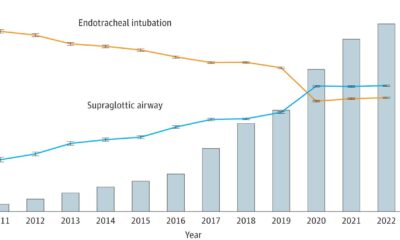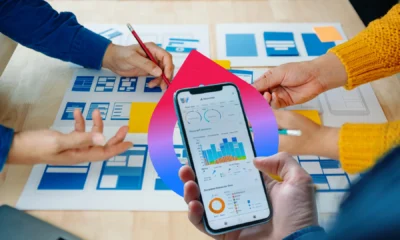Technology
How to Approach it For Mobile App?

Did you know around 90% of tech startups fail? The reason behind the majority of such failures is not considering the right target audience, appropriate features, and more. The MVP development process can help you mitigate such risks of failure as it covers all intricate details that should be in your app. This blog covers everything you need to know about building an MVP app, from understanding the concept to how to develop it to mistakes to avoid and more.
At global level, there are over 1.3 million abandoned apps on the Google Play Store and more than 496,000 on the Apple App Store. These staggering numbers highlight a significant issue that aspiring mobile app startups must address.
The reasons for these failures vary – poor UI/UX, inadequate features, lack of compelling use cases, and more. You can avoid these reasons behind the failure by leveraging the one powerful solution named the MVP (Minimum Viable Product) approach.
For startups and businesses aiming to expand their digital presence, MVP methodology offers a strategic gateway for quick entry in the market. Yet, many overlook the importance of validating their app idea with an MVP.
In this blog, we’ll delve into everything you need to know about MVP development. From understanding the core concept and benefits to practical steps for building a successful MVP app, we’ll guide you through avoiding common pitfalls and setting your app on the path to success.
What is an MVP?
Many people misunderstand MVP – Minimum Viable Product, as a product because it has a product written in the last, but it’s actually a process. MVP is more focused on repeating the loop of identifying unique problems, experimenting to validate them, and using the feedback to correct the product idea with iterations until the essence behind it is covered.
The MVP process helps to start small by launching the simplest and initial version of a product with core features only prioritizing solving user pain points.
Rather than spending thousands of bucks on developing and launching a polished application, this approach offers a cost-saving way to quickly market the product, validate the demand, and attract early adopters.
Through this process, even if your product fails, you still will save up on your significant resources.
With the MVP development process, you can go beyond the guessing game and invite the users (also known as beta users) to use your app and provide feedback to improve it.
So, when the full-fledged product is released, there will be fewer chances of failure and more chances to thrive in this competitive app marketplace.
Why are MVPs Important?
Around 90% of tech startups fail. To add on the reasons behind, CBInsights also reveals its study on such:
- 42% fail because of no market need
- 17% because of user-unfriendly product
- 17% because of a product without a business model
- 7% because of premature scaling
There are many other reasons associated as well. But these statistics are enough to understand the importance of building an MVP app.
Apart from that, below are the reasons why you should consider MVP app development for startup ideas of yours:
Launch Your Dream App Faster In the Market
As the MVP approach includes focusing on the core functionalities, businesses can develop and release the product faster and reach their target customers sooner.
The earlier the business makes the entry into the market, the better chances it obtains to get noticed and set the higher competition bar if the minimum viable product app is visionary and focused on solving particular challenges.
Bring Your Initial Product to Life At A Lowered Cost
The fewer features associated with the MVP, the fewer resources are required to work on the MVP development process. Of course, with the minimalism in the name, it does require a smaller team as compared to a full-fledged product, hence, resulting in reduced MVP development costs.
Another benefit of MVP development process is that it limits businesses from spending too much on features that might not be needed or wanted by users.
Attracts Early Adopters and Investors
The earlier you develop the product, the more chances you get to attract adopters. With a minimum viable product app, businesses can launch their product with less time to market and attract early adopters to try and test their product as a benefit of early adopters. If your product wins their trust, those users may advocate for your products and end up becoming your source for mouth marketing.
MVP development also gives businesses a chance to demonstrate their idea into a validated concept and present it in front of investors with data, increasing the likelihood of securing funding.
Minimizes Risks Associated with Product Failure in Latter Stages
Whether opting for MVP development for startups or for enterprises, it takes businesses in the early testing stage, helping them reveal technical and market-related problems before significant investment is made.
The MVP roadmap is designed to ensure that there is a demand for your product before committing to large-scale development.
How to Build MVP For Your App Idea? – A Step-by-Step Process
Just like the approach associated with developing a mobile app, the MVP development process revolves around similar principles, with slight variations such as inviting beta testers to enhance the minimum viable product.
At MindInventory, we bring years of experience in launching successful products for global clients. Our developed products have been featured as some of the best-designed and most unique app ideas in the category. Here’s our MVP roadmap:
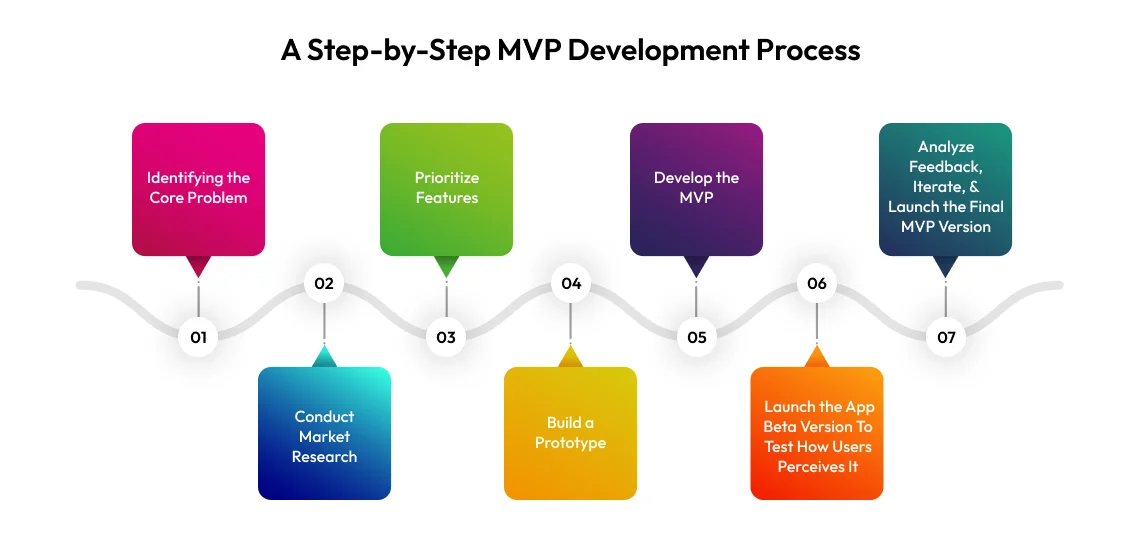

STEP 1: Identifying the Core Problem
The first step in building an MVP is to identify the core problem your app aims to solve.
Ask yourself:
- What specific issue does your app address?
- Why is this problem significant for your target audience?
- Why would your target audience use your app?
- How and when will this app come to their help?
- Will it have any business opportunities?
Understanding the core problem is essential to know because that lays the foundation for your product’s success. If the problem your app is trying to cover is non-existential, then going to its MVP process and even full-fledged app development will be a waste of time.
Defining the core problem gives you clarity on how to plan the MVP roadmap and what the product will mean to the audience and associated future scope.
STEP 2: Conduct Market Research
You’ve identified the core problem, which your app idea focuses on solving. But all the brainstorming can go to waste if it cannot fit into the market. Hence, market research around that app idea is a must to know the three important things:
- Know Your Users
- Know Your Competitors
- Know the Market Gap
For such, you should scope your market research by dividing it into four parts: Geographic, Demographics, Behavioral, and Psychographics.
MARKET RESEARCH PARAMETERS
Check out how these parameters help you scope your application and validate the concept:
Geographic
- Local Trends
- Market Size
- Localization Needs
Demographics
- Age & Gender
- Education & Occupation
- Income Levels
Psychographic
- Lifestyle Choices
- Values & Beliefs
- Personality Traits
Behavioral
- Potential Usage Patterns
- Purchase Behavior
- Feedback & Reviews
Are you building an app like Airbnb and Netflix? Then, your target audience is a global one.
What if you’re creating an on-demand taxi booking app like UBER? Then, you may have to consider the regional audience base more along with the app designed for each country you’re targeting.
Geographic survey helps you understand your user base and the business models they would be considering choosing.
Once targeting the geographic, it’s time to narrow down the research and make it more low-level to understand your target users and competitors closely. Demographics survey helps you understand the gender and age group of the audience, education & occupation levels, and how much they are willing to pay based on the average salary scale.
The next in line is a Psychographic survey that helps you understand the attitude, values, way of living, and more, to prioritize the quality of services they may expect from your app. Failing to do so can result in the failure of your application as well.
The last parameter is the Behavioral survey, which helps you know what types of apps and services users from the target market are using and how much level of loyalty they are showering to the businesses they are engaging with. This will set you up the benchmark for your services to make them your loyal customer base. It includes the creation of a user persona/buyer persona.
Competitor Research
The next in line is knowing your competitors and outsmarting them by not following their mistakes and getting the heads up to make your online service offerings better.
You can start by finding competitors from the Google Play Store and Apple App Store by searching for application listening under categories of your services offering areas.
When following this route, you can check their number of downloads, ratings, and reviews and identify users’ frustrations to prepare a list to make your product stronger to give your users an app they can rely on.
Isn’t it enough to identify the users, competitors, and market gap? Way more insightful than anything could give on. So, now, it’s time to list down what will go into your app!
STEP 3: Prioritize Features
When planning to shortlist the features for your mobile app, you come across many features, and identifying the ones for the MVP process can be a difficult task.
At that time, you should ask questions like:
- If a user downloads your app, what would they want from it?
- What would be the impact of implementing the feature in the app with or without?
- How would the project help users ease their tasks?
Considering all of these, you can categorize the features into four categories: Must Have (to be included in the MVP), Nice to Have, Can Have, and Too Much For An MVP.
Features Categories for An ERP Solution
Must Have (To Be Included in the MVP)
- User Management (Roles and Permissions)
- Interview and Candidature Tracking
- Employee Records Management
- Attendance and Leave Management
- Project Tracking
Nice to Have
- Finance and Accounting
- Payroll processing
- Sales and Order Management
- Basic Analytics and Reporting
Can Have
- Project planning and tracking
- Invoice
- Advanced Reporting and BI Tools
Too Much For An MVP
- Comprehensive CRM Suite
- Demand forecasting
- Automation Features
When you choose the last two matrices (Can Have and Too Much For An MVP), you can expect to add too much effort and resources just into the development of an MVP. Such should be avoided as MVP is mainly known for quickly marketing the product with required features only.
When you choose to go for the Must Have and Can Have feature categories, you can aim to create an impactful MVP as it’s more product and problem-solving-oriented.
If you choose the first two matrices (Must Have and Nice to Have), you should be cautious that Nice to Have can bring the level of experiments and innovative features that can associate risks. Moreover, these features are additional features that can be added later based on user feedback. In this scenario, there are two chances – either you can expect significant fame, or you’re doomed.
So, categorize and choose features for your MVP roadmap wisely.
STEP 4: Build a Prototype
Many people often get confused between a prototype and an MVP. But they are not the same and also not for the same audience. MVP is more end-user-oriented, whereas Prototype is for internal purposes to check how the product will look and function like when it’s implemented.
You can expect two steps associated with the prototype-building process:
- Creating Wireframes and Mockups
- Bringing Interactive Prototypes to Life
You first start with designing simple wireframes to outline the app layout and flow with information architecture. If that makes sense to the internal team, you can go ahead with developing clickable prototypes to simulate user interactions and gather preliminary feedback.
In the early phase of MVP development, prototyping an idea helps in refining the user experience and identifying any design flaws early on.
STEP 5: Develop the MVP
So, till here, everything that you want to include in your MVP app must be in line and clear. Now, all required is finalizing the right technology and finding the skilled talents to work on that. You can choose to outsource that to an app development company like MindInventory.
With technology, you also have to choose the right MVP methodology to execute seamlessly. Mostly, nowadays, businesses choose an agile methodology to develop the MVP in iterative cycles, allowing for flexibility and adjustments.
Of course, the app development team will develop the MVP considering all the parameters that an app should have. However, getting it tested by QA engineers can make a difference and save up lots of time and resources later on.
STEP 6: Launch the App Beta Version To Test How Users Perceives It
Though you have tested the app from a professional QA & software testing team, it’s a must to get it tested from the end-users side as well before launching it to the public.
For this, you can invite early adopters to use your MVP and provide feedback on app performance, user experience, and more features and functionality of the app.
Not just that, with MVP development, you can also track how users interact with the app, noting any issues or suggestions for improvement.
STEP 7: Analyze Feedback, Iterate, and Launch the Final MVP Version
The final step is to analyze the feedback received from beta testers and make necessary improvements.
You must have gathered feedback from beta users and data on their behaviors towards your app. You can then categorize those data to understand common issues and areas of enhancement.
Based on findings, implement changes and iterate on the app’s features and design.
Once the necessary adjustments are made, launch the final MVP version to a broader audience.
But…but…the work doesn’t end here. As we said earlier, MVP is not an end product but a process to continuously iterate based on user feedback and evolve the product into a solution that truly meets user needs and stands a better chance of success in the market.
Mistakes to Avoid When Building an MVP
The fit your product is in terms of market acceptance standards, the more chances it would have to succeed. MVP is your champion way to initially market your product with a minimal resource investment. You can’t fail at this process. Hence, you should know the possible mistakes you can make throughout your MVP roadmap.
Overcomplicating the MVP By Loading It With Features
Minimalism is in the name of the MVP development process. When you stuff it with too many features, it’s obviously overcomplicating the process. Adding excessive features can dilute the core value proposition, increase development time, and complicate user feedback. So, it’s best that you keep the MVP app development tidy with core features that solve the main problem for your target audience.
Trying to Build One-size-fits-all MVP
An MVP is an essential part of your product and your quick gateway to enter the market. Though your product is targeting a broad spectrum or planning to in the long run, the MVP should stay ground up with core problems. Attempting to build an MVP that pleases everyone can lead to a product that satisfies no one. It’s crucial to define your target audience and tailor the MVP to their specific needs.
Launching Unfinished MVP
While speed is important, launching an MVP that is too raw can backfire. An unfinished product can frustrate users and damage your reputation. Ensure that your MVP is functional and provides value, even if it’s not perfect.
Postponing Implementing Monetization Strategies
As you’re developing your business-specific product and its MVP, you definitely have monetization goals in mind. So, why wait for the product to get fame to implement the monetization strategies when you can do that from the MVP development stage? After all, it’s an iterative process to reach the aimed product.
An MVP should test not only the product’s feasibility but also its market viability. Including a basic monetization model from the start helps validate if users are willing to pay for your product. Their early feedback is valuable to adjust your pricing strategy and business model as per their behavior from the starting stage.
Targeting the Wrong Audience
This is the most common mistake most businesses make when they begin product development. It could be targeting all sorts of audiences out there or the wrong age group.
For example, you’re building an MVP for an on-demand video streaming app like Netflix but targeting all age groups at the start, from children to adults to elders. But if we sidestep that OTT platforms though have content targeting all groups, it’s obvious that its major contributors are the ones in their youth. So, when creating its MVP, you should begin with targeting youth first to gain traction.
Well, this is the basic app idea. What if your app concept is a unique one? At that time, getting help from professionals in digital product discovery and prototyping helps a lot.
Big Brands Who Succeeded In Business With MVP Development
In the dynamic world of startups and tech innovation, the concept of Minimum Viable Product (MVP) has proven to be a critical strategy for transforming simple ideas into global successes.
Many renowned brands have leveraged this strategy to achieve remarkable success. Here’s how some of the most influential companies turned their MVPs into industry leaders:
Airbnb
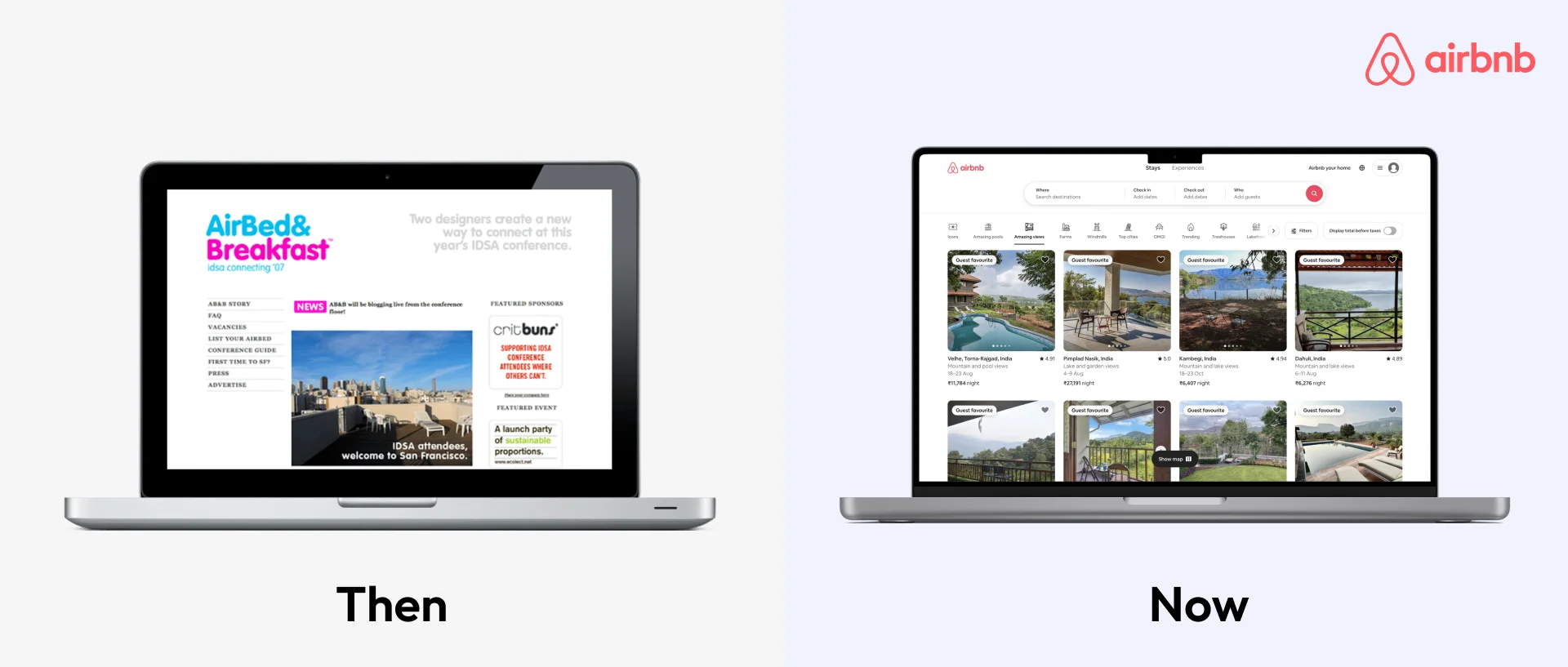

Back in 2007, with the cause of finding a stay while going to attend a conference meeting in a new place, as a solution, Airbnb launched its MVP – which allowed one to book an overnight stay with air mattresses, free breakfast, and WiFi, and unique staying and networking experiences.
Starting with the first booking of 3 guests with a billing amount of $80 each, Airbnb found a potential market opportunity.
Thanks to their initiation with MVP development, slowly Airbnb expanded to 100,000+ cities, received 150M+ worldwide users, successfully booked 1.5B+ stays, and more.
Amazon Shopping App


Amazon’s journey from an online bookstore to a global leader in multi-purpose e-commerce is a testament to its strategic vision and execution.
The initial version of Amazon’s website was meticulously crafted to facilitate book sales, featuring a streamlined catalog and a straightforward shopping cart. This MVP approach allowed Amazon to validate the concept of online retail and gather crucial user feedback, leading to rapid expansion of its product offerings to include electronics, clothing, household items, and more.
By 2021, Amazon had dethroned Walmart as the leading retail chain in the US. In 2023, Amazon achieved an impressive $575 billion in net sales revenue globally, solidifying its presence in over 50 countries.
Uber
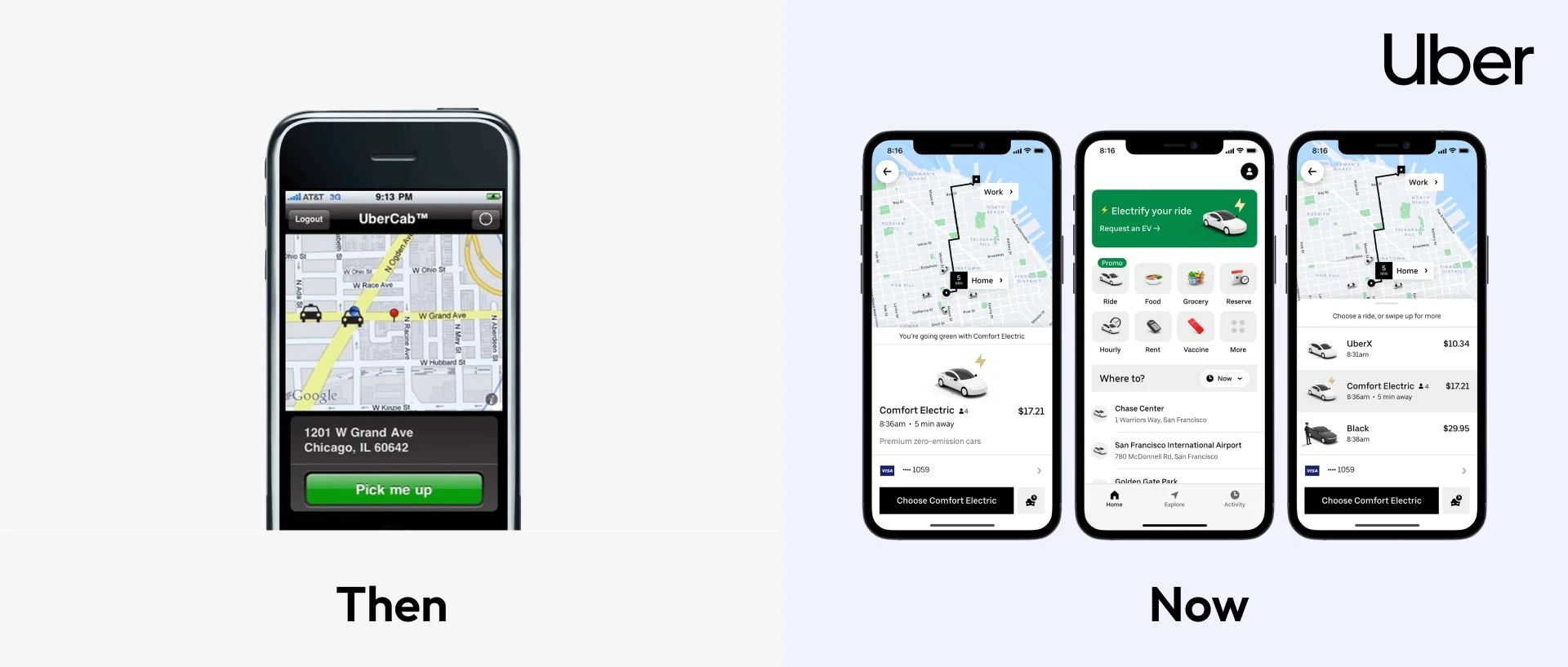

Uber started with a basic app that allowed users to request rides from drivers in San Francisco. Its MVP (i.e., UberCab) was first launched as an iPhone app development solution that allowed users to book and pay for rides using the SMS sent via the app. Initially, it was being operated as a luxurious car ride service in New York with an investment in 3 cars only.
By 2010, the founders noticed the caliber of UberCab MVP and started pivoting the data to iterate on the Ride booking app to target a larger market segment in San Francisco. The positive feedback also gave them the confidence to expand their businesses with service offerings like – Uber Eats, UberPool, UberX, and Uber Black (among others).
In 2015, Uber received a reputation as the most valuable startup in the world.
The success of this simple app paved the way for Uber’s rapid expansion and dominance in the global ride-sharing market, with a market cap of $134.57 billion.
How to Measure The Success of Your Mobile App MVP?
After the development and deployment of your MVP, it’s a must to check for its success to proceed with full-fledged product development. But how do you measure the success of your MVP app? Of course, by considering certain metrics, which are as follows:
1. User Acquisition Metrics
These metrics help you track the number of app downloads/installs and where you are in your initial goals. Also, with this, you check how each increasing user is costing you (in terms of Cost Per Acquisition (CPA)) and the worth of your burn rate in the marketing efforts. If it’s worth the cost, you get the hint to go ahead with optimizing marketing spend.
2. User Engagement Metrics
These metrics help you know the number of users engaging with the app on a daily and monthly basis to check for the user retention ratio. After that, if the users are coming back, it’s a must to check the average duration of each user session to get clarity on its ability to engage with users.
3. User Behavior Metrics
After getting information on users’ time spent on your app, you must know how they are spending their time in your app, like their navigation journey, where they are tapping the most, and more. This helps you know the features that are popular amongst users and focus more on improving such.
4. Financial Metrics
If you’ve implemented monetization strategies in your MVP, it’s a must to know the total income generated from it and the profit you’re making. Apart from that, it’s also beneficial to know the average revenue from a user and predict what they will spend in the future. This metric will help you aim at the long-term profitability and its worth to proceed with increasing investment in it.


How MindInventory Can Help You With MVP Development
MVP development offers many benefits to businesses planning to quickly get into the market and start building the user base. All those benefits can only be availed if strategically planned and followed the MVP roadmap throughout.
To do so, you’ll need help from experienced professionals to help you through your MVP development process, from market research and prototyping to final launch and even after that, offering full-cycle product development support.
When searching for such an alliance, MindInventory can be the one for you. We have years of experience in MVP development, helping global clients turn their innovative ideas into successful, user-centric products. Contact us today with your project requirements and get the best-fit solution around the problem you’re trying to solve with it.
FAQs on MVP Development
A prototype is an early model of a product used to visualize and test design concepts, typically not functional. An MVP (Minimum Viable Product), on the other hand, is a functional version of the product with just enough features to satisfy early users and gather feedback for future development.
An MVP is created in the early stages of product development to test the core functionalities with minimum resources and gather user feedback just after product discovery and prototyping.
The MVP product development process is carried out by including processes like defining the primary issue your product will address, understanding the target audience and their needs, determining the core app features and functionalities, building the MVP, and releasing it to gather user feedback and iterate it accordingly while staying relevant to the industry and market standards.
You can expect the cost for your MVP development project in the range of $10,000 to $100,000 or more. This costing depends on the factors like complexity, timeline, team expertise, tech stack used, and many others.
On average, you can expect to build your MVP within 6-12 weeks, but yes, if the complexity of the concept is higher, it may take more than that.





